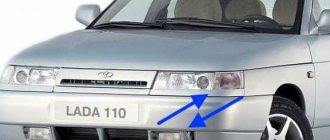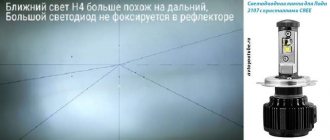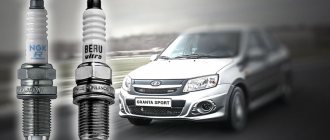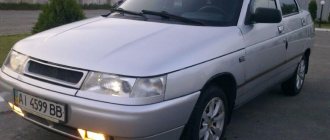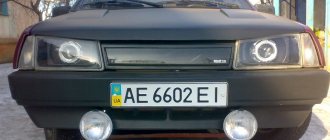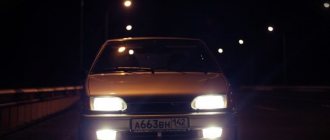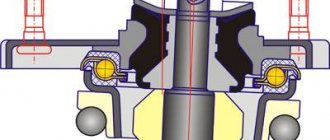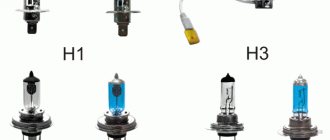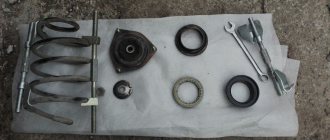Lamps in PTF, unlike the main road lighting, should provide illumination in poor weather and visibility conditions. The peculiarity of this light is that the radiation is not reflected from drops of moisture in the air and does not blind the driver. And although the factory installation of foglights is not provided for on all brands of cars, there is hardly a car enthusiast who will voluntarily give up such functionality.
Which socket is used in the fog lamp
PTFs are equipped with specialized moisture and vibration resistant bases. They differ among themselves in power and connectors.
When installing a lamp of a different type, more powerful than that provided by the base standard, you can cause the fuses to blow.
The following bases are more widespread on the market:
- H3 - designed for a power of 55 W;
- H8 - 35 W (H11 type lamps are suitable for it, but they are designed for higher power);
- H11 - 65 W;
- H27 - at 27 W.
All types of bases used in PTF.
Article on the topic: Types and markings of car lamp bases
Types of light bulbs used
There are three types of lamps for fog lights, each with different characteristics. In order to understand whether a particular light bulb is suitable for the PTF, you need to look at the manufacturer’s markings on the body or in the documents. If installed incorrectly, the headlight may produce an incorrect beam of light.
Halogen
These bulbs are the most popular on the market due to their efficiency and ease of installation and replacement. These are exactly what manufacturers install when they equip their car models with PTF. Halogen lamps have a warm light beam that penetrates well through rain and fog. The brightness of their light does not decrease over time.
The main disadvantages of halogen lamps are: sensitivity to vibrations and voltage changes.
For brighter light, some manufacturers add xenon to halogen lamps, which affects the cost.
The service life of halogen lamps is quite short , depending entirely on compliance with operating standards and the number of switches on/off.
Halogen bulbs are marked with the letter “H”. Headlights for them are marked with the letter “B” and are not intended for any other lamps.
Halogen lamps OSRAN fog breaker H8 35W.
Xenon
Gas-discharge or xenon bulbs are the brightest and most expensive. The characteristics of the light spectrum, as well as the service life of such lamps, are better than those of halogen lamps. Xenon lamps are resistant to voltage surges and require much less power than halogen lamps.
The installation of such light bulbs is complicated by the included components: ignition unit, tilt angle corrector and washer. That is why the installation of xenon lamps on cars not equipped for this by the manufacturer is prohibited by law. Another significant disadvantage is the decrease in light brightness over time , which occurs unnoticed by the driver, making it difficult to understand when it is necessary to replace the light bulb.
Design and principle of operation of PTF
The design of the fog lamp is not very different from the design of the head optics. As standard they include:
- housing with socket;
- deflector reflecting and directing light;
- diffuser;
- emitter.
The main difference from headlights is the nature of light distribution. PTFs are located below. The reflector is designed in such a way that the luminous flux is directed horizontally and downwards, illuminating the road surface, and not the space in front of the car. The reflector itself has a parabolic shape, the light hole is round or rectangular, which is most common. Due to their design features, the light of fog lights is not scattered or refracted, but illuminates the road surface and roadsides.
It is also believed that the yellow spectrum of fog lights penetrates fog better and is not reflected in it, although this has not been scientifically proven. That is why PTFs are most often equipped with a yellow filter.
Fog lights, regardless of the type of lamp, must have the following characteristics:
- powerful light emission (measured in lumens Lm);
- color temperature in the range of 2500-3200K, which gives the light a yellow tint;
- the light beam must be clear, not refracted in water droplets and penetrate fog;
- The PTF body must be made of heat-resistant plastic, taking into account aerodynamic requirements.
Is it legal to install xenon and LED lamps?
As of October 2022, xenon lamps are allowed to be installed in foglights only if the car’s headlights are intended for their use by the manufacturer - this is indicated in the car’s documents with the letters: “D”, “DC”, “DCR”. You must also always have a certificate of conformity or instructions for the machine with you. Unauthorized installation of xenon is prohibited and is punishable by Russian law with a fine and possible deprivation of rights for a period of one year.
According to the law, it is prohibited to use lamps with a luminous flux of any color other than white, yellow and orange in PTF. In addition to the fact that light of other shades does not penetrate through the fog, it can be blinding.
LED bulbs are blue, prohibited for PTF in the Russian Federation.
LED bulbs are also allowed to be used in foglights, provided the regulations are followed. The headlight must have the required markings and the lamp must comply with the requirements. Headlights marked “B” are not designed to accept LED bulbs.
The law prohibits the use of lamps with a luminous flux of more than 2000 lumens without auto-corrector. This applies to both xenon and LED.
How to choose PTF
- Even headlights with ideal light characteristics will be of no use if they are installed incorrectly. Therefore, when choosing, you need to take into account the possibility of installation and adjustment.
- Since fog lights are located close to the road, there is a high risk of stones and other debris getting into them. This can lead to damage to the case if it is plastic. Therefore, it is better to choose headlights with a thick glass body.
- If you buy dismountable fog lights, then if the light bulb burns out, it will be enough to replace only it, and not the entire headlight.
You can install PTF on a car only in specially designated places. If the manufacturer has not provided them, then the headlights must be mounted symmetrically relative to the longitudinal axis at a height of 25 cm.
Requirements for fog lights
When choosing anti-fog optics, it must meet the following requirements:
- durability of materials, good assembly. It is important that the housing is durable and airtight. As for glass, it is desirable that it be a mineral product and not plastic. Practice shows that pieces of ice or pebbles bouncing off the road surface often break plastic coverings;
- thoughtful aerodynamic configuration, reliable fastening. In this case, even when driving at significant speeds, you will not be disturbed by extraneous noise;
- collapsible design. In this case, when a light bulb burns out, it is enough to replace it, rather than looking for new headlights. The same goes for replacing cracked glass;
- fastening adjustment mechanism. If the PTF is adjusted incorrectly, they will dazzle other road users, which can lead to emergency situations on the road;
- installation only in designated areas. If this is not possible, then the products are fixed symmetrically. The distance from the road surface is at least 250 mm, and the maximum distance from the side clearance is 400 mm;
- power. Its limit values are 50-60 W. It is also important to know what types of lamps the optics are adapted for.
Which PTFs are better?
First of all, fog lights must illuminate the road in poor visibility conditions. Therefore, when choosing a PTF, you should first of all pay attention to the outgoing luminous flux. It should spread parallel to the road, covering part of the side of the road. The light should be bright enough, but not blind oncoming drivers.
Which ones are better to install in PTF?
Each type of light bulb has its own pros and cons. Halogen ones are the easiest to use, but compared to others they have to be changed too often. Xenon ones are bright and do not burn out for a long time, but not everyone can install them on a car due to legal restrictions and the complexity of installation. LEDs are the best option in terms of quality and service life, but they are also not available for installation by everyone.
The table below shows the main characteristics of the lamps for comparison.
| Average service life | Minimum price for 1 piece. | Maximum price for 1 piece. | |
| Halogen | from 200 to 1000 hours | 100 rubles | 2300 rubles |
| Xenon | from 2000 to 4000 hours | 500 rubles | 13,000 rubles |
| LED | from 3000 to 10000 hours | 200 rubles | 6500 rubles |
Which H11 lamps are best to buy?
Are there currently many offers on the market for LED and xenon lamps with H11 socket? And thoughts involuntarily arise - why not buy them too? And they shine brightly, and they have a good resource. Someone may nod towards the world's leading manufacturers: they say, the same Osram has LEDriving FOG Lamp H11 LED lamps. But large concerns write honestly: these lamps are not certified for public roads, that is, even the “giants” of automotive lighting development cannot make LEDs work normally in optics designed for halogen lamps. What can we ask from Asian companies, small firms, or even just basement stores, whose products are now filled with display cases? Such lamps not only shine frankly crookedly, but also the service life expected from LEDs cannot always be achieved with them. The fact is that halogen optics do not provide for any cooling of the lamp - after all, it works due to the hot filament. But for high-power LEDs, overheating is like death: the rate of crystal degradation increases significantly. In general, here our verdict is clear, as with the “collective farm” xenon – a firm “no”.
But you can already choose from H11 halogen lamps. For fog lights, perhaps, the best choice would be h11 lamps from the “long-lasting” category: among other things, an increase in service life is achieved by slightly reducing the temperature of the filament, that is, firstly, the light begins to “yellow” (and this happens in fog and rain - “just what the doctor ordered”), secondly, the heating of the diffuser is weaker, albeit by a few percent. Anti-fog optics themselves most often suffer due to their low location, and if the correct choice of lamp does not protect against a flying stone, it can protect against cracking glass when driving through a deep puddle.
For the same reason, lamps with increased brightness (or even increased power) carry with them a double loss for the wallet - one direct (because they cost more), and the second indirect: with such “stoves” in the headlights you should be careful in wet weather weather, otherwise you will have to look for new optics. In general, experiments with “amplified” lamps make sense only when choosing products from trusted manufacturers: lamps of Asian origin, for example, sometimes simply “kill” headlights by overheating.
Well, the most balanced choice, of course, was, is and will remain the lamps of the “standard” lines: they don’t seem to stand out with any specific properties, but they are cheaper than others and confidently do their job. It is not for nothing that these lamps are installed on the assembly line and delivered to dealer technical centers repackaged in branded boxes of a particular car plant: they know how to count money, so they will choose the real “strong middle peasants”.
Popular models
| Bulb type | Model | Description |
| Halogen | Philips LongLife EcoVision H11 | Designed for a long service life (minimum 2000 hours), has a bright yellowish light and is resistant to temperature changes. |
| KOITO WHITEBEAM III H8 | It has a white-yellow tint of light and an enhanced luminous flux, close to xenon. | |
| Xenon | Optima Premium Ceramic H27 | It is resistant to physical impact thanks to the additional ceramic ring, lights up in 0.3 seconds and has a very budget price. |
| MTF H11 6000K | It starts quickly when cold, is protected from short circuits in the on-board network and, according to the manufacturer, has a service life of 7000 hours. | |
| LED | Xenite H8-18SMD | One of the cheapest and highest quality models on the market, it has a wide beam angle, consumes only 1.5 W and is capable of operating at temperatures from -40 to +85 °C. |
| SHO-ME 12V H27W/1 | Also an inexpensive model, characterized by a consumption of 2.6 W, the color of the glow is similar to daylight. |
Video tests of LED lamps.
Best H1 High Brightness Bulbs
Osram Night Breaker Laser H1580 (cardboard, 1 pc.) Osram's "plus-fifty percent" H1 lamps are not only brighter, but also better quality than their previous "+130%" generation. Those had worse light distribution, and there were some complaints about the resource. I am glad that, having achieved an improvement in light output, Osram has also improved the previously noted problematic characteristics. The "lifetime" of the lamps has increased, approaching the average results of standard lamps - for "reinforced" lamps operating at elevated filament temperatures, this is a good sign of quality. However, we note that these lamps are still sensitive to shaking and shock: in headlights they usually work longer than in fog lamps. However, in terms of color temperature, they are better suited specifically for main headlights; bright white light in fog is not particularly helpful. As for the price, everything is traditional here - the Night Breaker line has never been cheap. Although any “amplified” lamps are usually two to three times more expensive than standard ones from the same manufacturer, so what? Here you have to select the gas composition of the flask filling more cunningly, and not just any glass will work for the flask - you need to reliably filter the increased share of ultraviolet radiation in the spectrum, because polycarbonate, which is now popular for making headlight lenses, does not tolerate it well. Main advantages:
Minuses: High price | 9.7 / 10 Rating Reviews In the distance - it’s the same, they hit like a spotlight. |
Philips WhiteVision H1360 (blister, 1 pc.) Lamps in the H1 base have a good service life and at the same time provide a noticeable improvement in visibility compared to standard Philips lamps or their equivalents from other manufacturers. Of course, it is difficult to check by eye whether these lamps really improve visibility by 60 percent, as the manufacturer promises, but on the road you can see for yourself that their light is definitely better than the “standard” one, and the price is still quite reasonable. Therefore, we recognize WhiteVision lamps as the “golden mean” of today’s rating of the best H1 lamps: the price is good, they are not deprived of resources, and they shine better than average. In a word, our recommendation has been received, even if these lamps are not the brightest ones presented in the store, but for the money they are simply excellent. Main advantages:
Minuses: Not the highest range | 9.5 / 10 Rating Reviews I’m already rolling out my second set, and I’ll probably choose them for the next replacement too. |
PIAA Night Tech H12 100 (cardboard, 2 pcs.) The bright white light with a slight yellowish cast shines far, which involuntarily causes concern and a desire to look for the ominous inscription “not for sale in Europe” on the packaging. But no: on the contrary, compliance with the requirements of the ECE R37 standard is emphasized. The lamps not only depict the roadside well, but also allow you to see “surprises” in your lane in the distance in advance. True, the cost of these H1 lamps takes away all the fun: more than a thousand rubles per piece! This is simply killer, especially considering that the base is outdated, and for owners of used cars, the issue of price is not the least important issue. Although the lamps undoubtedly shine well and have a decent service life, it is precisely because of the price that it is difficult to recommend them for purchase - the same “Nightbreakers”, which are not cheap in themselves, can be replaced twice for the same amount. Main advantages:
Minuses: Unreasonably high price | 9.0 / 10 Rating Reviews They work well, the light is powerful - but when they burn out, I’ll probably install something cheaper. |
Tips for choosing
When choosing bulbs for foglights, you should be guided primarily by what was intended to be installed on the car by the manufacturer, since the law on xenon and LED lamps in PTF is constantly becoming stricter.
On the left is an original OSRAM lamp, on the right is a fake.
If you don’t look at the law, then the next parameter is finance. Cheap lamps exist in all varieties, but while halogen lamps for a hundred rubles will work tolerably well, the same cannot be said about xenon and LED lamps. Also read tips on adjusting PTF.
Best H11 Bulbs for Off-Road Use
OSRAM Fog Breaker H111 850 (plastic, 2 pcs.) To some extent, it’s a pity that these lamps did not pass ECE certification: with their “long range” and rich yellow color, they are perfect for fog lights. In fog, on a wet road, or on snow, they provide excellent visibility, rendering everything in good contrast and without tiring your eyesight. Due to the lower filament intensity, they also make the thermal mode of the headlights easier - and this is again an excellent “bonus” for fog lights; the likelihood of damage to the glass when driving through puddles is reduced. And, since we are talking about “off-road” lamps, puddles on the road are guaranteed to occur. Let's add to this the good service life of the lamps - and again we will regret that these lamps are “illegal” at the additional stage. Although they will openly start to hurt your eyes only in the main optics - and in PTF, to be honest, your hands are very itching to use them on public roads... Main advantages:
Minuses: Not the most attractive price | 9.8 / 10 Rating Reviews The fog lamps work just like a plus, compared to conventional lamps - heaven and earth. |
OSRAM Cool Blue Boost H111 800 (plastic, 2 pcs.) And again, in our rating of the best h11 car lamps, of course, Osram - no, they did not bring an envelope to the author, even though he did not refuse. Here, the impossibility of use on the DOP is indicated not only by the “Off-Road” icon on the packaging: the rated power of these lamps is no less than 75 W (previously it was 80). As a result, we get quite a compact spotlight, although not with the most comfortable light for vision (5000 K). But, if luminous flux is important to you, then, undoubtedly, these lamps will provide it in full. Moreover, unlike those lamps where they try to reduce the increased luminous flux while maintaining the standard power for the H11 base of 55 W at the cost of reducing the resource, Cool Blue Boost is also quite durable. Another thing is that when installing them, you need to take a closer look at both the choice of optics (the heating will be decent) and the wiring. Because of the same heating, such lamps will be a dubious choice for fog lights: those on off-road will begin to swim in water first, but in some kind of “chandelier” on the roof, the likelihood of lenses cracking due to water getting on them will be minimal. Main advantages:
Minuses:
| 9.4 / 10 Rating Reviews They hit very far, this cannot be taken away - but by “road” standards, of course, absolutely not as it should be. |
